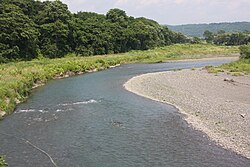| Niikappu River | |
|---|---|
 | |
| Native name | |
| Location | |
| Country | Japan |
| State | Hokkaidō |
| Region | Hidaka |
| District | Niikappu |
| Municipality | Niikappu |
| Physical characteristics | |
| Source | Mount Poroshiri |
| • location | Niikappu, Hokkaidō, Japan |
| • coordinates | 42°43′9″N 142°40′58″E / 42.71917°N 142.68278°E |
| • elevation | 2,052.4 m (6,734 ft) |
| Mouth | Pacific Ocean |
• location | Niikappu, Hokkaidō, Japan |
• coordinates | 42°21′42″N 142°18′17″E / 42.36167°N 142.30472°E |
• elevation | 0 m (0 ft) |
| Length | 80 km (50 mi) |
Niikappu River (新冠川, Niikappu-gawa) is a river in Hokkaidō, Japan.
Course[edit]
The Niikappu River flows south to southwest from Mount Poroshiri[1] in the Hidaka Mountains. The river flows through four dams, including Niikappu Dam and Okuniikappu Dam. Both dams are owned by the Hokkaido Electric Power Company, Inc.[2] The dams form Lake Niikappu and Lake Poroshiri, respectively. After 80 kilometres (50 mi),[3] the river empties into the Pacific Ocean.[4]
References[edit]
- ^ 地図閲覧サービス 2万5千分1地形図名: 幌尻岳(夕張岳) (in Japanese). Geographical Survey Institute. Retrieved 2009-05-20.
- ^ "Profile" (PDF). Hokkaido Electric Power Company, Inc. 2008-03-31. Retrieved 2009-05-20.
- ^ 新冠川その一. Home Page of Niikappu Town (in Japanese). Niikappu Town. Retrieved 2009-05-20.
- ^ 地図閲覧サービス 2万5千分1地形図名: 静内(浦河) (in Japanese). Geographical Survey Institute. Retrieved 2009-05-20.
Well, that’s interesting to know that Psilotum nudum are known as whisk ferns. Psilotum nudum is the commoner species of the two. While the P. flaccidum is a rare species and is found in the tropical islands. Both the species are usually epiphytic in habit and grow upon tree ferns. These species may also be terrestrial and grow in humus or in the crevices of the rocks.
View the detailed Guide of Psilotum nudum: Detailed Study Of Psilotum Nudum (Whisk Fern), Classification, Anatomy, Reproduction